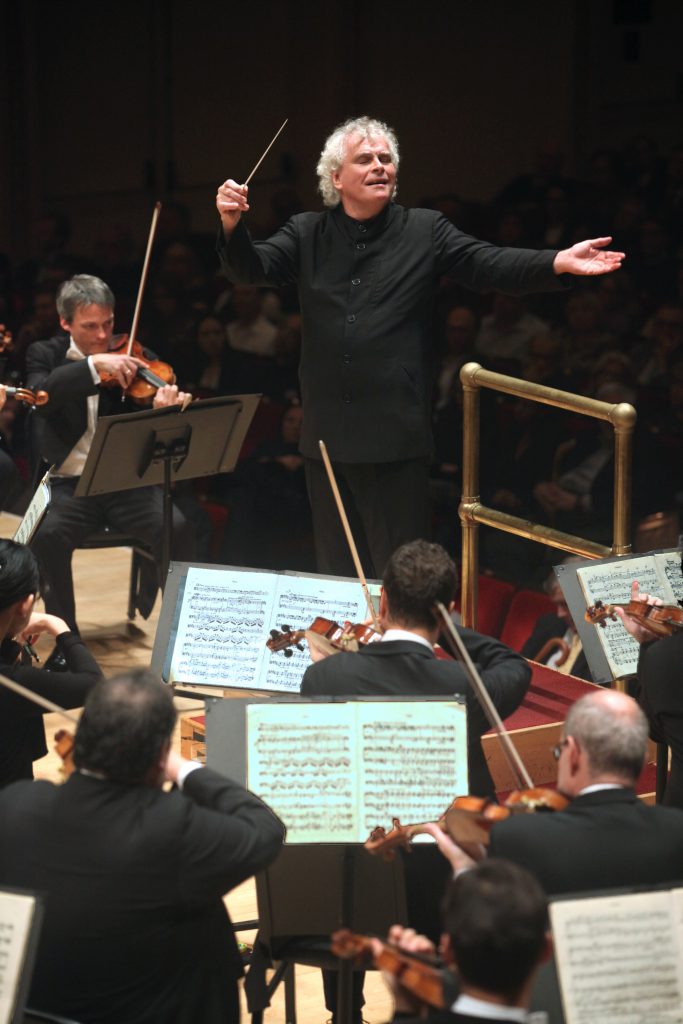Rattle, Berlin Philharmonic contrast dark and light in powerful New York farewell

Simon Rattle conducted the Berlin Philharmonic Orchestra Thursday night at Carnegie Hall.
For the past decade and a half, Sir Simon Rattle’s tenure leading the Berlin Philharmonic Orchestra has been one of the world’s great artistic partnerships. It’s difficult to imagine that relationship coming to an end, but so it will; Rattle’s appearance with the BPO at Carnegie Hall Thursday night marked his final New York performance as the storied orchestra’s principal conductor.
Anyone expecting mushy sentiment from the maestro’s sendoff concert was in for a surprise. A selection of early-ish pieces for orchestra by Schoenberg, Webern, and Berg may not have shown quite the rigid, hardcore atonalism into which they dove even deeper in their later careers, but an hour spent with the Second Viennese School is never a cakewalk.
Speaking from the stage, Rattle announced a reordering of the first half of the program and asked the audience not to applaud until all three sets had been completed, and to treat them rather as a continuous performance. The request was unusual, but it allowed Rattle and the orchestra to weave the three collections together, so that they seemed almost three movements of one integral symphonic work.
Part of what made this approach so effective is that each set indeed has its own character and hangs together as a single construction. Rattle ably charted the wandering arc of Schoenberg’s Five Pieces for Orchestra, Op. 16, from the forcefully pulsating “Vorgefühle” through the dizzying, razor-sharp peaks of the “Peripetie,” and finally to the ominously simmering conclusion of “Das obligate Rezitativ.” He found little moments of playfulness throughout, gurgling characters that rose up in the most unexpected moments.
The Schoenberg led seamlessly into Webern’s own churning darkness. The Six Pieces for Orchestra, Op. 6b, are dominated by an oppressive murk, and there is a definite art to channeling that general haze into something with specific communicative power. Rattle, of course, was masterful in the realization, drawing a stark contrast between the dark, stewing colors and the eerie clarity of the chimes on top.
Of the three sets, Berg’s Three Pieces, Op. 6, shows the clearest delineation among its constituent parts, functioning here as a microcosm within the grander construct that Rattle was stringing together. After the coy opening of the Präludium he quickly whipped the BPO strings into a burning, aggressive force. The cheeky, grim echoes of a waltz in the Reigen were executed with superb flair, ducking nimbly in and out of chaos, followed by a more nebulous, general confusion in the manic Marsch.
Such illuminating performances of such complex repertoire would have made for a rewarding concert on their own. Yet Rattle & co. followed with a reading of Brahms’s Symphony No. 2 that made for an extraordinary finish.
Energetic stylist that he is, Rattle showed no shame at all in approaching the symphony’s opening movement with massive, cushioned, Romanticism. Gauzy, pining horns combined with warmly sighing strings to fill out the rich textures of the first movement. Within the grand scope of the piece, remarkable little episodes with character all their own stood out, exquisitely crafted and fitting perfectly into place. With music as familiar as this, conductors are often tempted to put some sort of a stamp on it. In Rattle’s hands what we heard most was the voice of Brahms the artist, ever striving for emotional power.
He guided the orchestra with a supple hand in the second movement, and the precision of the players brought into relief every intricacy of dynamic, tempo, and articulation. The BPO certainly deserves its reputation for polish, playing tightly together and producing a gleaming sound, but they bring such variety of color into their work that there is never the sense of lacquered consistency that many top-tier orchestras can fall into. The scherzo, though not the most boisterous that Brahms wrote, was a joy, maintaining delicate grace even where it thrummed with excitement.
Some of Rattle’s choices were not especially subtle–pianissimos in the finale were taken down to a true whisper, giving a thrilled hush before cranking all the way back up to the essential brawn of the music. His intricate plan, executed with precision and communicated with clarity, had a heart-racing effect, instilling fierce determination in even the music’s most bucolic bars. The proud, thrilling conclusion was just about as perfect a coda to Rattle’s Berlin career as a screenwriter could have devised—a final eruption of power and majesty.


